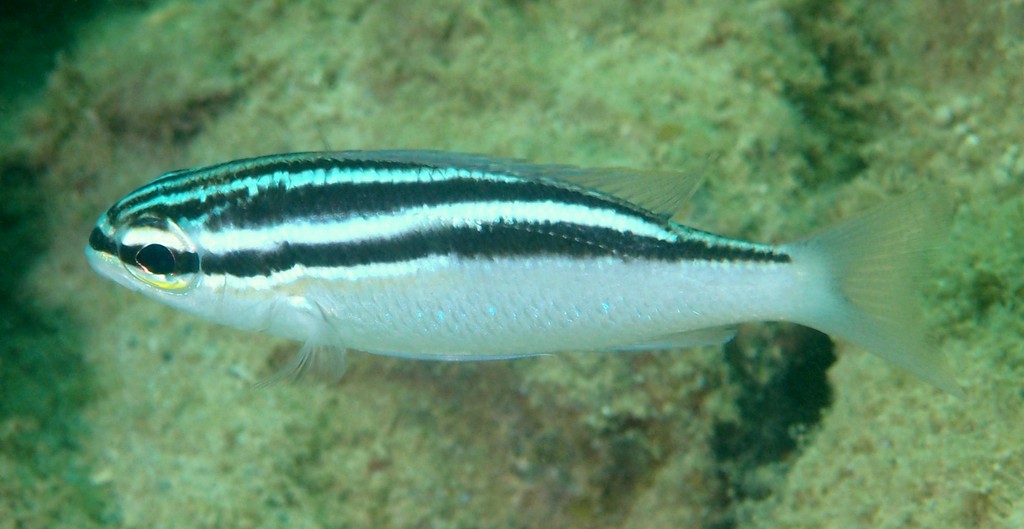SCOLOPSIS TRILINEATA - (KNER, 1868)
Actinopterygii (Gigaclass) > Actinopteri (Class) > Teleostei (Subclass) > Acanthuriformes (Order) > Nemipteridae (Family) > Scolopsis (Genus)
Scolopsis à trois lignes, Three-line monocle-bream, Three-line spinecheek, Three-lined monocle bream, Threeline spinecheek, 三線眶棘鱸,
Synonyme
Scolopsis trilineatus (Kner, 1868)
------------------------------
Description
Dorsal spines (total): 10; Dorsal soft rays (total): 9; Anal spines: 3; Anal soft rays: 7; Pectoral rays: 16; 2 1/2 Scale rows between lateral line and dorsal fin base: 2 1/2. Head scales reaching forward to level of middle of eyes. Lower limb of preopercle naked. Antrorse (forward-directed) suborbital spine absent. Pelvic fins long, reaching to or just beyond level of anus. Axillary scale present. Max. length: 25.0 cm TL, common length: 14.0 cm SL. Depth range: 1 - 20 m.
Color
Brown on back; A white line from upper edge of eye to middle part of dorsal fin; A second white line from eye to the end of dorsal fin; A third white line beneath eye curving upwards and joining the second line at lateral line; Three bluish-white stripes on snout; Dorsal, pelvic, and caudal fins transparent.
Etymology
Scolopsis: from Greek, scolops or skolos = splinter, sting also designates a pointed or pointed wood, stake + from ancient Greek, óps = eye, face, which has the appearance of. The genus name, created in 1814 by Georges Cuvier, “is due to its very particular character, which is that the second sub-orbital terminates in a rounded and usually serrated lobe, bearing at its angle joining the orbit a spiny point, directed backwards, which most often crosses with another point, given by the third sub-orbital directed forwards, but sometimes hidden by the skin”. Histoire Naturelle des poissons - Tome 5 - 1830 - Chapter XII p327.
trilineata: from Latin, tri = three + from Latin, lineatus, a, um = lined. Referring to three white stripes from head to dorsal fin of adults.
Orginal description: Scolopsis trilineatus Kner, 1868 - Type locality: Savai'i Island, Samoa.
Distribution
Eastern Indian Ocean, western Pacific: eastern Indonesia, east to Samoa, north to Taiwan, south to northern Australia and New Caledonia.
Biology
Inhabits sandy bottoms in lagoons and areas close to reefs and mangroves. Occurs singly or in small aggregations.
Last update: 10, September 2024
Scolopsis à trois lignes, Three-line monocle-bream, Three-line spinecheek, Three-lined monocle bream, Threeline spinecheek, 三線眶棘鱸,
Synonyme
Scolopsis trilineatus (Kner, 1868)
------------------------------
Description
Dorsal spines (total): 10; Dorsal soft rays (total): 9; Anal spines: 3; Anal soft rays: 7; Pectoral rays: 16; 2 1/2 Scale rows between lateral line and dorsal fin base: 2 1/2. Head scales reaching forward to level of middle of eyes. Lower limb of preopercle naked. Antrorse (forward-directed) suborbital spine absent. Pelvic fins long, reaching to or just beyond level of anus. Axillary scale present. Max. length: 25.0 cm TL, common length: 14.0 cm SL. Depth range: 1 - 20 m.
Color
Brown on back; A white line from upper edge of eye to middle part of dorsal fin; A second white line from eye to the end of dorsal fin; A third white line beneath eye curving upwards and joining the second line at lateral line; Three bluish-white stripes on snout; Dorsal, pelvic, and caudal fins transparent.
Etymology
Scolopsis: from Greek, scolops or skolos = splinter, sting also designates a pointed or pointed wood, stake + from ancient Greek, óps = eye, face, which has the appearance of. The genus name, created in 1814 by Georges Cuvier, “is due to its very particular character, which is that the second sub-orbital terminates in a rounded and usually serrated lobe, bearing at its angle joining the orbit a spiny point, directed backwards, which most often crosses with another point, given by the third sub-orbital directed forwards, but sometimes hidden by the skin”. Histoire Naturelle des poissons - Tome 5 - 1830 - Chapter XII p327.
trilineata: from Latin, tri = three + from Latin, lineatus, a, um = lined. Referring to three white stripes from head to dorsal fin of adults.
Orginal description: Scolopsis trilineatus Kner, 1868 - Type locality: Savai'i Island, Samoa.
Distribution
Eastern Indian Ocean, western Pacific: eastern Indonesia, east to Samoa, north to Taiwan, south to northern Australia and New Caledonia.
Biology
Inhabits sandy bottoms in lagoons and areas close to reefs and mangroves. Occurs singly or in small aggregations.
Last update: 10, September 2024
